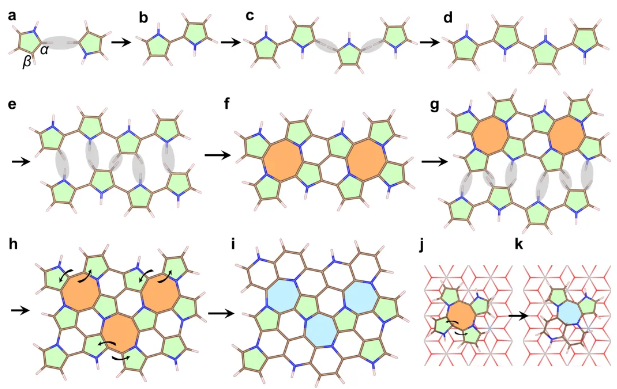On September 25, 2024, Nature published the latest progress made by the research teams led by Prof. Guo Lin and Prof. Liu Limin from Beihang University and their collaborators in the controlled synthesis of nitrogen-doped amorphous monolayer carbon. The study, titled “Nitrogen-doped amorphous monolayer carbon”, proposed a solution-phase synthesis strategy using nanoscale two-dimensional confined templates for small-molecule polymerization, successfully preparing nitrogen-doped amorphous monolayer carbon materials.

This research addresses long-standing challenges in the synthesis of two-dimensional amorphous materials, opening up new avenues for their applications in materials science, electronic devices, and other cutting-edge technological fields. The co-first authors of the paper are Ph.D. candidate Bai Xiuhui, Associate Researcher Hu Pengfei, Ph.D. candidates Zhang Youwei and Xue Yufeng from Beihang University; Ph.D. candidates Li Ang and Li Aowen from the University of Chinese Academy of Sciences; and Associate Researcher Zhang Guangjie from the National Center for Nanoscience and Technology. The corresponding authors are Prof. Guo Lin and Prof. Liu Limin from Beihang University, Researcher Qiu Xiaohui from the National Center for Nanoscience and Technology, Prof. Zhou Wu from the University of Chinese Academy of Sciences, and Prof. Lin Gu from Tsinghua University.
In 1995, Nobel Laureate P. W. Anderson highlighted in Science that the nature and formation mechanism of amorphous materials are some of the most profound and intriguing questions in condensed matter physics. Unlike the periodic atomic arrangement in crystalline materials, the disordered structure of amorphous materials makes their properties difficult to predict and control. As early as 1932, Prof. W. H. Zachariasen from the University of Chicago proposed the “Continuous random network” model, using two-dimensional network structures to describe the unique structural characteristics of amorphous materials. In 1996, Steven G. Louie, a member of theAmerican Academy of Arts and Sciences, predicted in Phys. Rev. B that two-dimensional amorphous carbon materials could include complex structures composed of five-membered and seven-membered rings. However, the precise synthesis of such unique monolayer amorphous materials remained a challenging problem.

Fig. 1 Structural characterization of nitrogen-doped amorphous monolayer carbon
In this study, the researchers demonstrate the solution preparation of free-standing nitrogen-doped amorphous monolayer carbon with mixed five-, six- and seven-membered (5-6-7-membered) rings through the polymerization of pyrrole within the confined interlayer cavity of a removable layered-double-hydroxide template. Structural characterizations and first-principles calculations suggest that the nitrogen-doped amorphous monolayer carbon was formed by radical polymerization of pyrrole at the α, β and N sites subjected to confinement of the reaction space, which enables bond rearrangements through the Stone–Wales transformation. The spatial confinement inhibits the C–C bond rotation and chain entanglement during polymerization, resulting in an atom-thick continuous amorphous layer with an in-plane π-conjugation electronic structure. The spatially confined radical polymerization using solid templates and ion exchange strategy demonstrates potential as a universal synthesis approach for obtaining two-dimensional covalent networks, as exemplified by the successful synthesis of monolayers of polythiophene and polycarbazole.

Fig. 2 The proposed formation process of the NAMC with 5-6-7-membered rings from the pyrrole molecules
This research was supported by the National Natural Science Foundation of China, the National Key R&D Programme, the Strategic Priority Research Program of the Chinese Academy of Sciences, the Excellent Young Scientists Fund of Beijing universities, etc.
Link to the article: https://doi.org/10.1038/s41586-024-07958-0
Written by: Liu Shaojia
Reviewed by: Liu Kesong
Edited by: Jia Aiping
Translated by: Han Xu

